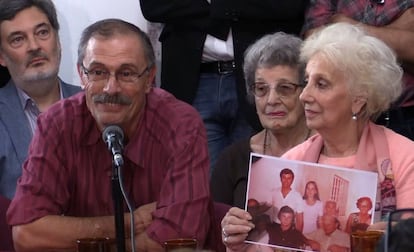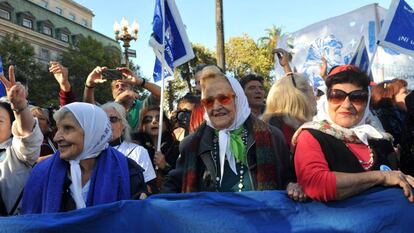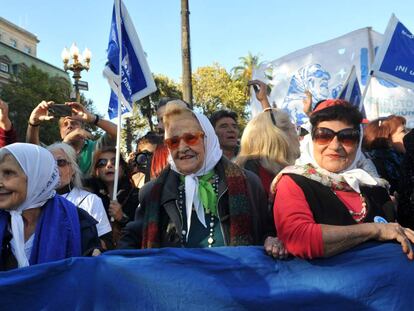Grandmothers of the Plaza de Mayo find child who went missing during Argentina’s dictatorship in Spain
The 42-year-old woman, who is the 129th person the organization has helped locate, is yet to meet her real father and older brother


Carlos Alberto Solsona was driving his car down a freeway in Santiago, Chile, when he received a call from Buenos Aires, Argentina informing him that the DNA of a 42-year-old woman living in Spain was a match. After decades of searching, the Argentine father had found his daughter. His wife Norma Síntora was believed to have given birth to the girl while detained in one of the illegal detention centers set up in Argentina during the country’s military dictatorship, which lasted from 1976 to 1983. Solsona never had an opportunity to meet his daughter.
No one has any idea about the thousands of sleepless nights I spent waiting for this moment Carlos Solsona, father of granddaughter 129
“No one has any idea about the thousands of sleepless nights I spent waiting for this moment,” he said at a press conference on Tuesday organized by the Abuelas de Plaza de Mayo (the Grandmothers of the Plaza de Mayo), a human rights organization dedicated to locating and reuniting the families of the children who disappeared during the dictatorship.
The president of the organization, Estela de Carlotto, announced at the press conference that Solsona’s daughter was the 129th child the group had located. That number has steadily risen since 1977 when the organization began its tireless work to recover the stolen identities of some 500 children who were born in military dungeons during the dictatorship.
Solsona also has a son called Marcos, who was raised by his grandfather and is the woman’s older brother. A family reunion between the three is yet to take place, as Solsana wants to proceed with caution and not rush the process. “I don’t like to imagine situations, because I am very afraid of hurting her. She has a life, she’s more than 40 years old and this is dropped on her. That is my biggest worry. I don’t want to [hurt her],” he said on Tuesday.
A number of children born to pregnant woman in detention centers were given to military families shortly after their birth
The 42-year-old woman, known as “granddaughter 129” to protect her identity, was found thanks to the work of the Grandmothers of the Plaza de Mayo. Carlotto explained that in 2012, the organization came across a case of a young woman with a questionable birth certificate who had “been born at home.”
The organization got in touch with the woman a year later and invited her to come to Argentina and complete a genetic test to see whether her DNA matched with one of the families of the dictatorship victims. “The woman lived abroad [in Spain] and she said was planning on coming to Buenos Aires in 2014 to continue talking about the possibility of taking a test,” says Carlotto. But this never happened. Contact was lost until one of the woman’s friends intervened in June 2017, and convinced her to take the test. “Two weeks ago, the new granddaughter came to the country and went to court on April 3. She agreed to do the analysis, which showed that she is the daughter of Carlos Solsona and Norma Síntora.”
Solsona and his wife met as engineering students in Córdoba, Argentina in 1974. They married the following year and had Marcos. After the military overthrew the government of President Isabel Perón in March 1976, the couple became political militants with the People’s Revolutionary Army (ERP). By 1977, Solsona had left the country in hopes of reuniting with his wife and son in Spain. However, on March 21, 1977, Síntora, who was eight months pregnant, was kidnapped by the military and placed in a detention center where she gave birth.
I am in my seventies, and I started searching for my daughter when I was in my thirties
Carlos Solsona, father of “granddaughter 129”
In the early 1980s, Solsona located his son Marcos, who was being taken care of by his maternal grandparents, and they kept in contact by sharing photographs and letters. However, Solsona still had not found any trace of his newborn child. The news at the time reported on the number of children born to pregnant woman in detention centers who were given to military families shortly after their birth.
“I created a sort of defense mechanism, a shield so that this wouldn’t destroy me. I am in my seventies, and I started searching for my daughter when I was in my thirties.This has meant that I have had to live carrying a weight that gets heavier every single day. But we never lost hope. We searched neighborhoods, we went wherever there was the smallest clue, to speak with people who asked us, ‘So, are you looking for a child?’,” said Solsona.
Solsona is now preparing to meet his daughter, a grown woman who will have to rebuild her life story with an unknown father and brother. He knows it will be difficult, but also “amazing.”
Grandmothers of the Plaza de Mayo

In 1977, 14 women gathered in a Buenos Aires square known as Plaza de Mayo. They were looking for their children, who had disappeared at the hands of the military dictatorship. They spontaneously decided to join forces in order to force the military junta to give them some answers.
The regime wrote them off as “those crazy women,” but they didn’t care. Week after week they marched around the central monument on Plaza de Mayo to demand that their children be returned to them alive, and given a proper trial if if turned out that they had committed any crimes.
The movement did not peter out even when three of its members were kidnapped in late 1977, including founder Azucena Villaflor. Now mostly octogenarians, the group still go to the square every Thursday.
English version by Asia London Palomba.
Tu suscripción se está usando en otro dispositivo
¿Quieres añadir otro usuario a tu suscripción?
Si continúas leyendo en este dispositivo, no se podrá leer en el otro.
FlechaTu suscripción se está usando en otro dispositivo y solo puedes acceder a EL PAÍS desde un dispositivo a la vez.
Si quieres compartir tu cuenta, cambia tu suscripción a la modalidad Premium, así podrás añadir otro usuario. Cada uno accederá con su propia cuenta de email, lo que os permitirá personalizar vuestra experiencia en EL PAÍS.
¿Tienes una suscripción de empresa? Accede aquí para contratar más cuentas.
En el caso de no saber quién está usando tu cuenta, te recomendamos cambiar tu contraseña aquí.
Si decides continuar compartiendo tu cuenta, este mensaje se mostrará en tu dispositivo y en el de la otra persona que está usando tu cuenta de forma indefinida, afectando a tu experiencia de lectura. Puedes consultar aquí los términos y condiciones de la suscripción digital.
More information
Archived In
Últimas noticias
Most viewed
- Alain Aspect, Nobel laureate in physics: ‘Einstein was so smart that he would have had to recognize quantum entanglement’
- Maps of the US attack on Venezuela: Targets, airspace and deployed fleet
- Key points of the military attack on Venezuela: Early morning bombings and a ‘captured’ president
- Oil, gold and rare earth elements: the backdrop to US political tension with Venezuela
- The US bombing of Venezuela, in pictures










































